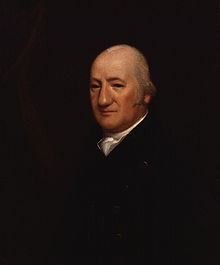Henry James Pye
Henry James Pye (ur. 10 lutego 1744, Londyn, zm. 11 sierpnia 1813, Pinner) – angielski poeta, którego twórczość przypada na oświecenie i początki romantyzmu. W roku 1790 otrzymał tytuł poeta-laureat[1]. W 1784 roku został wybrany do parlamentu[2]. Gdy opuścił miejsce w parlamentarnej ławie, został szefem policji w Westminsterze. Jako poeta był autorem między innymi tomu Poems on various subjects (Wiersze na różne tematy[3]). Wydał też poemat Beauty[4]. Poza tym napisał tragedię Adelaide[5].
Ambitną próbą rodzimej wielkiej epoki był obszerny poemat Alfred[6]. Dzieło Pye’a, podobnie jak inne ówczesne utwory o anglosaskim władcy Alfredzie Wielkim, poematy Johna Fitchetta i Josepha Cottle'a miało budzić w Anglikach uczucia patriotyczne i dumę narodową, niezwykle istotne w latach walk z Napoleonem. O literackich portretach króla Alfreda pisał Simon Keynes[7]. Współcześnie Henry James Pye należy do autorów zapomnianych.
Przypisy
- ↑ Henry James Pye, [w:] Encyclopædia Britannica [online] [dostęp 2020-07-08] (ang.).
- ↑ PYE, Henry James (1745-1813), of Faringdon, Berks. | History of Parliament Online, www.historyofparliamentonline.org [dostęp 2020-07-08].
- ↑ Poems on Various Subjects by Henry James Pye in Two Volumes, ornamented with Frontispieces, Vol. I, John Stockdale, London 1787.
- ↑ Beauty, a Poetical Essay. In Three Parts, by Henry James Pye, T. Beckett, P. A. de Hondt, London 1766.
- ↑ Adelaide: a Tragedy in Five Acts, by Henry James Pye, John Stockdale, London 1800.
- ↑ Alfred, an Epic Poem, by H[enry] J[ames] Pye, London 1815.
- ↑ Simon Keynes, The cult of Alfred, [w:] Anglo-Saxon England 28, Cambridge 1999, s. 329-330.
Media użyte na tej stronie
Henry James Pye, by Samuel James Arnold (floruit 1800-1808), given to the National Portrait Gallery, London in 1962. See source website for additional information.
This set of images was gathered by User:Dcoetzee from the National Portrait Gallery, London website using a special tool. All images in this batch have a known author with unknown death date, but according to the NPG's website the author was floruit (known to be active) prior to 1859, and so is reasonably presumed dead by 1939.
